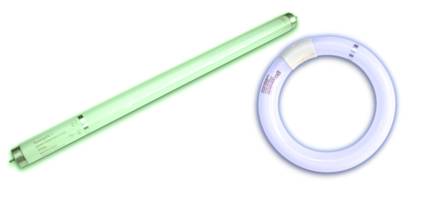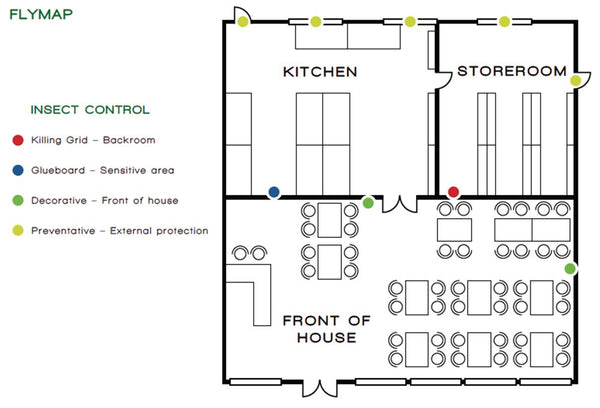FAQ's
Why Use an Electronic Fly Killer?
Even well designed businesses with exceptional cleaning and hygiene standards may still have flying insects entering through the front doors, open windows or as deliveries are made, etc. In the interests of food safety and customer satisfaction businesses must control this problem. One of the best ways of doing this is the use of Electronic Fly Killers.
How Does a Fly Killer Work?
Fly Killers utilise ultraviolet tubes to attract flying insects into the product, before either zapping them dead on a high voltage killing grid or trapping them on a sticky glue board. UV tubes attract flying insects by emitting a wavelength of light attractive to flies. Flying insects are attracted to the tube which emits UV at a level comparable to that of the sun, which the flying insect has a natural attraction to as a source of heat.
What Is A Bug Zapper / Fly Zapper?
Electric Bug Zappers or Fly Zappers use ultraviolet tubes to attract flying insects into the unit, before 'zapping' them dead when they touch a high voltage killing grid. UV tubes attract flying insects by emitting a wavelength of light attractive to flies. Dead flies are then caught in a catch tray to allow hygienic disposal. The name stems from the characteristic 'zap' sound produced when an insect is electrocuted.
What is a Glue Board Fly Killer?
Glue Board Fly Killers are designed to be discreet in their function of trapping flying insects. Similar to Fly Zappers, they use UV light to attract flying insects to the unit where the insect is then caught on a sticky glue board. They are silent in operation making them ideal for sensitive areas such as hotel lobbies, restaurant dining areas and other commercial front of house areas. Glue Board Fly Killers that are designed to be indistinguishable from wall lights. They are effective against all flying insects including flies, fruit flies and moths.
Whilst both types of units are very effective in flying insect control, Glue Board type units are recommended in food preparation areas instead of fly zapper units. The main reason for this is that, as a result of research and legislation, it has been found that insect debris can travel outside the fly zapper unit and could lead to food contamination. This can occur when the fly is electrocuted (or zapped) and particles can be exploded outside the unit resulting in food contamination. It can also occur if a wind or breeze blows dead flies or body parts out of the catch tray at the base of the unit.
Why Choose Glupac® Glue boards?
Glupac® glue boards are designed to perfectly complement your Insectomatic glue board or decorative fly killer, offering consistently high standards of performance and quick servicing times. Glupac® glue boards feature simple grids to make it quick and simple to monitor and record fly counts and identify species. This allows valuable, accurate feedback to be kept for hygiene audits and shared with the end user on a regular basis.
Glupac® glue boards feature simple grids to make it quick and simple to monitor and record fly counts and identify species. This allows valuable, accurate feedback to be kept for hygiene audits and shared with the end user on a regular basis.
Glupac® release paper is silicon coated to ensure that it releases from the glue covered board quickly and simply, leaving the glue in place. This guarantees speedy service times and ensures that there is no contact between the glue and the service technician.Unique flexible glue application allows for maximum glue area
- Advanced UV stable glue guards against the glue drying out over a four week period
- Dry glue formulation reduces glue run from exposure to tube heat and mess free servicing
- Consistent thickness of glue application ensures no areas are too thin to retain the caught insect
- Varnished base material reduces absorption of the glue
- High quality silicon coated release paper provides easy peel action and less mess for reduced service times
- Impregnated glue contains pheromone Tricozene Z9 for an improved catch
How Often Should I Change my Glue boards?
We recommend that glue boards are changed every 4 weeks, to prevent the glue from drying out over a longer period of time. Particularly dry or dusty environments may require a more frequent change as atmospheric debris may become attached to the board.
How Often Should UV Tubes be Changed and Why?
We recommend that UV tubes are changed every 12 months to ensure maximum efficacy.
The levels of UV produced by fluorescent tubes deteriorates rapidly throughout the life of the tube. Whilst the tube will continue to glow blue or green indefinitely, after approximately 8,000 hours the amount of useful UV (which humans cannot see) drops to a level where it is no longer attractive to flying insects. As a result , UV tubes must be replaced annually to ensure they remain effective in producing useful levels of UV. This replacement cycle is typically undertaken just before the peak insect season, to ensure the fly killer is producing the maximum amount of UV throughout the critical insect season.

Easily recognised by their glowing green light, Synergetic® tubes have been developed to attract a much wider range of flying insects than traditional blue UV lamps.
Based upon a unique phosphor mix, patented technology ensures that a broader ‘ two peak’ wavelength is maintained (368nm and 540nm) attracting a wide range of insects including stored product moths, whilst attracting the common housefly as effectively as traditional blue UV tubes, giving you the best of both UV technologies.
Extensive testing has been carried out over many years by independent entomologists and test laboratories, showing the benefits of green light in combination with UV.
A wide diversity of insects were shown to be more attracted to Synergetic® light, including greenhouse whiteflies, silverleaf whiteflies, thrips, leafhoppers, Indian meal moths, Mediterranean flour moths, tropical warehouse moths, warehouse moths, plus many more!
What is Shatterproofing?
Shatterproof tubes provide peace of mind in sensitive areas by retaining glass shards if the tube is broken. All our ranges can be shatter proofed, ensuring that you can choose your ideal tube to help you protect even the most sensitive areas, including food preparation and assembly areas. Shatterproof tubes MUST be installed in areas operating a ‘glass free policy’.

The Fluorinated Polymer (FEP) material used for all our sleeving is designed specifically for optical transmission and allows 97% of effective UV light to pass through the coating. As a result, the maximum possible amount of useful UV irradiance passes through the sleeving to effectively attract insects. With only 3% of the irradiance being absorbed into the material, the structural integrity of the sleeving is maintained for the full 12 month life of the tube, preventing discolouring and ensuring all glass shards are retained in the event of a breakage.
Additionally, all our shatterproof tubes meet the requirements of the IEL61549 ‘Fragment Retention’ standard for areas where this is considered appropriate.
How do I Install a Fly Killer?
Every application is unique, so each situation requires an individual assessment for fly killer siting, however, there are basic principals that should be followed:
- Recommend enough Electric Fly Killers to cover the area to be protected in line with the recommended coverage guidelines for each model
- Install Electric Fly Killers away from sources of light competition, such as windows, doors and high powered luminaires
- Consider sources of heat and airflow, such as heaters / AC units
- Don’t install Electric Fly Killers directly above sensitive areas, such as food preparation areas
- Glue board fly killer units should be used in sensitive applications such as food preparation or production areas
- Consider access for installation and future servicing
- Wherever possible, Electric Fly Killers should be positioned at 90° to sources of natural light, such as windows, doors and skylights
- Electric Fly Killers should be positioned in between potential entry points, so as to intercept flying insects before they reach sensitive areas
- Electric Fly Killers should not be sited either too high or too low in the area to be protected, with an optimum height of around 2m, for most flying insect species

